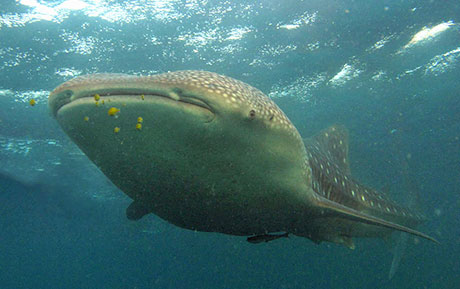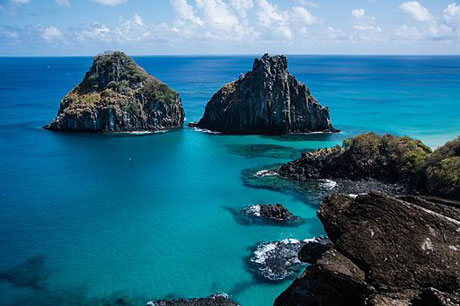

6 June 2023
Brazil has 7490 km of coastline, but perhaps the best diving is 350 km (220 miles) off the north east coast at Fernando de Noronha. This mountainous archipelago comprises 21 sparsely populated islands. A national park and UNESCO World Heritage Site since 2001, Fernando de Noronha boasts warm water; caves, caverns and tunnels; spectacular rock formations and many, many reef and pelagic creatures.
Another good diving area is Laje de Santos Marine Park, near Sao Paulo in the south. This is famous for masses of manta rays.
São Pedro & São Paulo (not to be confused with the mainland city of the same name mentioned above) is a small and isolated oceanic archipelago located in the equatorial mid-Atlantic Ridge. It is a hotspot for pelagic fish like sharks and may serve as a stopover during large-scale migrations. Most of these species gather at the archipelago between January and June.

Photo by Tim Nicholson
You might see whale sharks in coastal waters from Ceara to Rio Grande do Sul States and at oceanic islands, like the archipelagos of Fernando de Noronha, Sao Pedro & Sao Paulo and Trindade. The best time to see them in Sao Pedro and Sao Paulo is from January to June, probably due to food availability.1
Brazil shares borders with every South American country except Chile and Ecuador. On entering Brazil you will need to be able to demonstrate that you have enough money for the duration of your stay, and provide details of your accommodation and evidence of return or onward travel. Make sure your passport is stamped. If it is not, you may be fined on departure. Keep your immigration landing card. You'll need it when you leave. If you lose it you may be fined. Your passport should be valid for a minimum period of 6 months from the date of entry into Brazil. Make sure you have travel and medical insurance before you travel.
Fernando de Noronha • Laje de Santos• Abrolhos• Angra dos Reis
Find a dive operator in Fernando de Noronha.
Peaks of the Southern Atlantic submarine ridge form the Fernando de Noronha archipelago (and Rocas Atoll). They represent a large proportion of the island surface of the South Atlantic and their rich waters are extremely important for the breeding and feeding of tuna, shark (including hammerheads), turtle, billfish and marine mammals. The islands are home to the largest concentration of tropical seabirds in the Western Atlantic. Baia de Golfinhos has an exceptional population of resident dolphin and at low tide the Rocas Atoll provides a fantastic seascape of lagoons and tidal pools teeming with fish. An oasis of marine life in relatively barren, open ocean.
You can dive Fernando de Noronha all year. The best visibility is during September and October.

Morro Dois Irmãos (Two Brothers Hill), Fernando de Noronha. Photo credit: CCINTRA (CC BY-SA 3.0)
" Exuberant
stadium-like rock formation, 16m max depth and 30m average visibility,
with abundant marine life, from reef and nurse sharks to small
multicoloured reef fish. It is also a national park, so it is protected
by law. Brazil's best, by far!"
Jose Luiz Flores da Cunha
"Open sea
dive, several small caverns and coral reef formations. A lot of small
creatures, small shrimps, colourful school of fishes. Some lobsters and
octopus. Encounters with Lambarus (Lime Sharks) and some hammerhead
sharks, manta ray, eagle ray and more pelagic creatures."
Andrea Lopes Gallinaro
"Regarding
Pedras Secas dive site, its name means dry stones in Portuguese. Is an
arena like formation, surrounded by small passages and small caverns
and cracks in the rocks. The local divemaster will guide you through
the best parts of the site and will always call your attention to the
wonders that come into sight, deep range from 12 to 20 meters and
there is no strong drift, so relax and enjoy the dive. Marine life can
be described as unique and plentiful. Colourful fishes habituated with
the presence of divers and some are even curious about the divers,
getting closer to take a look at "such a strange creature that makes
bubbles". There is no need to be lucky to find nurse sharks and green
turtles, they are always around. Try sneaking in the small holes and
slits in the bottom and you will probably find some lobsters, crabs,
shrimps and octopuses ready to show their quick colour changing show.
Quite often, eagle rays and reef sharks can be seen. With some luck,
you may encounter Manta Rays and Hammerhead Sharks, an unique
experience. All this, spiced with a warm water (27oC / 80oF),
visibility ranging from 15 metres (50 feet) in the bad days to more
than 30 metres as an standard. There are three good operators in
Noronha, but I strongly recommend using Atlantis, the second choice is
Aguas Claras.
While not diving, you can enjoy
the wonderful beaches, where snorkelling is always welcome, and
several tracks with amazing landscapes. Food is always good, based on
local fishes. You can even find a sushi-bar with fresh tuna sashimis.
The only set back is the accommodations, you will not find 5 stars
hotels, only small "pousadas" with no luxury. Despite rustic, all
accommodations are clean and usually count with air conditioning,
small fridge and TV. At night, experience the local music at the Bar
do Cachorro, and try dancing a little Forró! Futher to the Pedras
Secas dive site, there are several other dive sites, which will lead
you to dive for as many days as you can while you are in the island.
It is worth mentioning the Corveta, a
warship wreck technical dive that can be made by divers with more than
50 logged dives and Nitrox certified."
Carlos Roberto dos Santos
The Corvette sank in 1982 after hitting an uncharted rock. She rests at 60 m and is in very good condition.
" A warship
wreck technical dive that can be made by divers with more than 50
logged dives and Nitrox certified. "
Carlos
Roberto dos Santos
Laje de Santos Marine Park is famous for its gathering of giant manta rays, Manta birostris. Traditionally this occurred between May and September, but in some recent years the rays have arrived as early as March. Laje de Santos is 25 nautical miles from the port of Santos which is near the city of São Paulo.
Find a dive operator in São Paulo.
There are several dive sites at Laje de Santos. At the easterly end is the wreck of the fishing boat Moreia, at 22 m. She was deliberately sunk in 1995 to attract both marine life and divers. According to the Laja Viva Instituté "Depending on the conditions, cold water and currents may turn this into an uncomfortable dive, but it does not present huge difficulties if the dive is guided by someone that knows this dive site."
At the west end is a deeper dive, Anchor Ledge. Several anchors from fishing boats have been lost among the rocks, and these are frequented by big grouper and pelagic fish. Maximum depth is 40 m. Nearby is "Swimming Pools", a lovely dive spot with many turtles and even more fish. Depth from 6 to 35 m.
Two miles southwest from Laje is Calhaus. This rock formation includes a U shaped tunnel and an arch reaching above the water. You can see large pelagic schools of fish and several species of rays.
More information about Laje de Santos is at the Laje Viva Instituté site. This non-profit organisation is dedicated to preserving and protecting the Laje de Santos Marine State Park.
" An oceanic
rock, 70 miles from shore of SP state where pelagics find some
harbour. Further to the abundant marine life, there is small and
pretty conservate trawler wreck to explore."
Andrea Lopes Gallinaro
"Several
people come to the main city in South America for business reasons and
forget their diving equipment. While in São Paulo, you get a car and
in less than one hour you are in Santos, where you get a boat and
within another one and a half hour you will be at Laje de Santos. It
is a 400 m rock emerging 70 kilometres from the shore. There are dives
for all levels of certification, with deeps ranging from 14 m to more
than 40 m. Visibility sometimes turn into a lottery there are reports
of less than 5 m but usually you will find 15 m and sometimes more
than 25 m. Several parrot fishes and angel fishes will be surrounding
you. A small trawler wrecked is a welcomed surplus to the site.
Starfishes and octopuses can be found in the rocks. Quite often there
are encounters with the main visitor of such site, the Manta Rays,
which turns an already good dive in such site into a unique
experience. "
Carlos Roberto dos Santos
Abrolhos covers an area of 913 sq km, including an archipelago of four (out of five) islands. It was Brazil's first marine park and is found in the northeast of Brazil. Charles Darwin, aboard the HMS Beagle, visited here in 1832. The dry season, with the best visibility, is from May to September. The archipelago is an important breeding and calving area for humpback whales in July to November. The area is rich in coral reefs. Caravelas is the most popular gateway to Abrolhos.
"There is an amazing diving site called Abrolhos. Fantastic place. It is an island, so you have to stay in the boat. I stayed 3 days there and was very well impressed. "
Carla Crippa
"Acaiá tip. Diving with clear water, but it is recommended to be the first of the day because the sea conditions change before noon. Many rocks forming passages, and for the more experienced divers there is a cave. Maximum depth of 12 meters, but the most interesting is 5 meters.
"
Livia Fonseca, Vdiver Escola de Mergulho, 2013
"Ideal for those who want a peaceful and diving with lots of life. It is possible to see turtles and seahorses in the shallows. Sheltered spot, favored by divers basic. Maximum depth: 12 meters. "
Livia Fonseca, Vdiver Escola de Mergulho, 2013
"Ideal One of the few wrecks that can be seen in a free diving. Situated 7 feet deep, the wreck of the helicopter is situated in Lage Matariz of the Big Island. You can not enter because it is a small wreck, but yields very nice photos."
Livia Fonseca, Vdiver Escola de Mergulho, 2013
Recommend a dive operator or list your diving company on this page.
Fernando de Noronha • Natal • São Paulo • Santa Catarina• Angra dos Reis • Arraial do Cabo • Volta Redonda • Alagoas • Vitoria
Caju Divers
576 Av. Engenheiro Roberto Freire
Ponta Negra
Natal
Brazil
Tel: +55(84)3089-0109
E-mail: contato@cajudivers.com
cajudivers.com/
Iate Clube do Natal
Natal
Rio grande do Norte State
Tel: 55 84 30913128
Email:maresub@maresub.com.br
"Mar Sub Divers have the best diving in Natal since 1995. 15 years
diving and making friends."
Mar Sub Divers, 2011
"One of the two diving operators in the region. "
Alexandre
Atlantis Divers
Caixa Postal 20
Fernando de Noronha - PE
CEP: 53990-000
Tel: +55(84) 3206-8840
info@atlantisdivers.com.br
"There are three good operators in Noronha, but I strongly recommend using Atlantis."
Carlos Roberto dos Santos
Aquamergulho
R. da Mooca
3435 - Mooca
São Paulo - SP
03165-001
Brasil
Tel: +55 11 2729-0300
Av. Antônio Bertholdo da Silva Jordão
7346 - Monsuaba
Angra dos Reis
Brasil
Tel: +55 (21) 2524-4000
Rua Nilo Peçanha
24 Shop A - Praia dos Anjos
Arraial do Cabo
Brasil
Tel: (22) 2622-1045
E-mail: Esportes@Divers.com.br
PL Divers
Rua Nilo Pecanha, 57,
Praia dos Anjos,
Arraial do Cabo
Brasil
Tel: 02226224802
E-mail: pldivers@pldivers.com.br
Rua São Pedro, 60
Niteroi
Volta Redonda-RJ
Brazil
Tel: 24 3338-9220
"The Vdiver Dive School is located in Rua São Pedro, 60 - Niteroi, Volta Redonda-RJ/Brazil. The cost of diving is acessible, and the school provides diving courses and conducts tours for non-divers. Is a very personalized service, the company fits the schedules of students. Output value dive with full equipment: R$ 225. Discovery (dive for non-divers): R$ 200.
"
Livia Fonseca, Vdiver Escola de Mergulho, 2013
Let's Dive - Mergulho e Aventura
Rua Conde de Irajá nº 60
Bairro Pajuçara
Maceió
Brasil
E-mail: info@letsdive.com.br
Sea Divers
Rua Luiz Boiteux Piazza
6562 Ponta das Canas
Florianópolis
Santa Catarina
Brasil
Tel: +55-48-3284-1535
E-mail: seadivers@seadivers.com.br
ACQUA SUB
Rua Anísio fernandes Coelho
30, Loja 01
Jardim da Penha
Vitória - ES
Brasil
Tel: (27) 3325-0036
E-mail: acquasub@acquasub.com.br
For hotels in Brazil see the Agoda site...
1Whale Shark (Rhincodon typus) Seasonal Occurrence, Abundance and Demographic Structure in the Mid-Equatorial Atlantic Ocean. Bruno C. L. Macena , Fábio H. V. Hazin, October 26, 2016
Please send us your comments on Brazil. Do you want to recommend a diving centre or dive site? Let us know. Have a question - we're waiting to hear from you. If you own a dive centre get yourself added.
By Jill Studholme